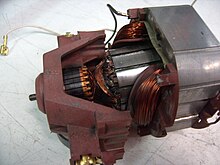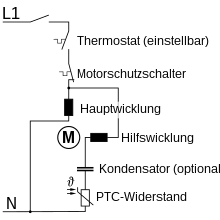AC motor
AC motors are electric motors that are operated with single-phase alternating current , i.e. with only one outer conductor (phase) from the three-phase alternating current . AC motors can work on different principles. A rotating field is not already given by the feed. Additional structural measures are therefore necessary in order to achieve a rotary movement.
Single-phase series motor
The single-phase series motor, also known as the universal motor for low outputs , is a simple form of the AC motor. Its principle is derived from the direct current motor . Like this one, it is one of the commutator machines. The rotary movement is achieved by a commutator ( commutator ). This motor is suitable for all devices and tools of daily use, as it only requires a small installation space due to the high speeds and generates a high starting torque. Its speed and power can be adjusted via phase control . Universal motors for applications in the household sector are produced with outputs of up to 3 kW .
The rail motor previously used in electric railways is also a single-phase series motor. Usually built with outputs of more than 3 kW, these motors have now been largely replaced by asynchronous motors with frequency converters as drives for railways .
Capacitor motor
In the capacitor motor, the main winding is connected directly to the mains and an auxiliary winding is connected in series to the mains via a capacitor . An elliptical rotating field is created, which is sufficient to start the motor, but which in principle impairs energy efficiency and smoothness during operation. For higher starting torques, starting capacitors - often bipolar electrolytic capacitors - are used which, after reaching the nominal speed, are disconnected from the circuit, for example by a centrifugal or magnetic switch.
Three-phase asynchronous machines can be operated with reduced power and uneven torque on a single-phase network if they are wired with capacitors. This circuit is known as the Steinmetz circuit . However, the windings of the three-phase asynchronous machine differ fundamentally from those of the capacitor motor.
Shaded pole motor
In the shaded pole motor , the rotating field is generated by a magnetic field that is out of phase with eddy currents . For this purpose, each pole of the stator is split and one half is provided with a short-circuit ring or a short-circuit winding that can be switched off so that the magnetic field is built up there continuously or with a delay when starting.
Single-phase asynchronous motor
A simple version of the AC motor is the single-phase asynchronous motor , historically also referred to as a starter motor because of its operating behavior . A special feature of this motor is that it has no torque when it is at a standstill, so it does not start up automatically. It is set in rotation, for example, by hand or other external aids. From a certain speed , the motor runs up to the rated speed in the starting direction. A weak auxiliary winding that switches off after startup is widespread in refrigeration compressors in household appliances.
Due to its inexpensive production, it was used as a drive machine, for example in agricultural equipment, in the mid-20th century. Since only a single-phase winding is used in the stator, the single-phase asynchronous motor can be manufactured with less material and more cost-effectively than the three-phase asynchronous motor, but it has a poorer efficiency and an uneven torque. To change the direction of rotation, the motor must be stopped and started in the other direction.
The structure of the single-phase asynchronous motor, like the three-phase asynchronous machine, is equipped with a squirrel- cage rotor . The only phase in the stator does not generate a rotating field . There is an opposing magnetic field between the squirrel-cage rotor and the stator due to the short-circuit windings. However, if you push the motor in one direction, the magnetic field excited in the short-circuit windings moves with the squirrel-cage rotor. As a result, the magnetic fields are no longer perpendicular to each other and the repulsive forces generate a torque in the direction triggered, which accelerates the motor to almost the line frequency.
The uniaxial alternating field, which is generated by the alternating voltage, can be equally divided into two equivalent but opposing circular fields, formed by two-phase alternating current , within the framework of the symmetrical components . The single-phase asynchronous motor is modeled in this substitute model by two antiphase and series-connected two-phase motors on a common shaft. When the motor comes to a standstill, the two torques of the two sub-motors cancel each other out - after starting in one direction, the rotary motion occurs, as the one modeled sub-motor generates a higher torque than the counter-rotating sub-motor due to the speed.
A starting circuit with an auxiliary winding is also suitable for starting the single-phase asynchronous motor. The phase shift for the rotating field is usually caused by an ohmic resistance in series with the inductance of the auxiliary winding. The auxiliary phase can be switched off by a current relay in series with the main winding. A PTC resistor is more common today , which heats itself up after being switched on and becomes high-impedance after a short time. However, after it has been switched off, it first has to cool down so that the engine can start again. Centrifugal switches are also useful. For the various approaches, the terms starting device or, in the case of the PTC resistor, “starting relay” are used incorrectly.
The output of the single-phase asynchronous motor is approx. 50% of a three-phase asynchronous motor of the same size. The low power is related to the poor winding factor compared to three-phase machines , since approx. 1/3 of the winding space with the slots in the stator cannot be used due to the principle. The starter motor is rarely used today.
Occasionally, however, the term “starter motor” simply means a small motor (generally not a single-phase asynchronous motor) that is used to start a large motor.
Repulsion motor
The repulsion motor is a special design of a single-phase asynchronous motor in which the position of the brushes can be adjusted mechanically for the purpose of speed and torque setting. In this way, for example, a particularly high torque can be achieved when starting, which allows the engine to be started almost smoothly under load.
Other procedures and methods
Another type of AC motor is the reluctance motor , which, in contrast to normal asynchronous motors, continues to run as a synchronous motor at a synchronous speed after starting up . Special rotor plates with pronounced poles cause this behavior.
Also, synchronous motors can be operated at reduced power single phase under certain conditions; they then need, among other things, a start-up aid and run unevenly.
Another and very universal way, which has now replaced almost all other engine systems is an asynchronous motor with an electronic frequency converter to operate, which the single-phase AC voltage rectifies and subsequently into three-phase alternating current with a rotating field electronically converts. With this fixed combination of a frequency converter and an asynchronous motor, in addition to the choice of different power supplies and voltages, operation on DC voltage, such as batteries , as well as speed adjustment and selection of the torque on the motor is possible in a wide range, which among other things enables the implementation of highly dynamic Drive systems in fully automatic machine tools or in the field of electromobility .
literature
- Rolf Fischer: Electrical machines . 16th edition. Carl Hanser Verlag, 2013, ISBN 978-3-446-43813-2 .
- Günter Springer: Expertise in electrical engineering. 18th edition, Verlag Europa-Lehrmittel, Wuppertal 1989, ISBN 3-8085-3018-9 .
- Ernst Hörnemann, Heinrich Hübscher: Electrical engineering specialist training in industrial electronics. 1st edition. Westermann Schulbuchverlag, Braunschweig 1998, ISBN 3-14-221730-4 .
- Gregor D. Häberle, Heinz O. Häberle: Transformers and electrical machines in power engineering systems. 2nd Edition. Verlag Europa-Lehrmittel, Haan-Gruiten 1990, ISBN 3-8085-5002-3 .
Individual evidence
- ↑ a b Jaroslav Štěpina: The single-phase asynchronous motors - structure, theory and calculation . Springer, 1982, ISBN 978-3-7091-8660-2 , Chapter 3.4: The single-strand single-phase motor (starting motor), p. 53-65 .
- ^ Franz Moeller, Otto Repp: Electric motor and machine. Springer-Verlag, 1936, ISBN 978-3-662-01845-3 .
- ↑ Rodundwerk II - power plant cross-section. ( Memento from August 14, 2014 in the Internet Archive ) on: illwerke.at

